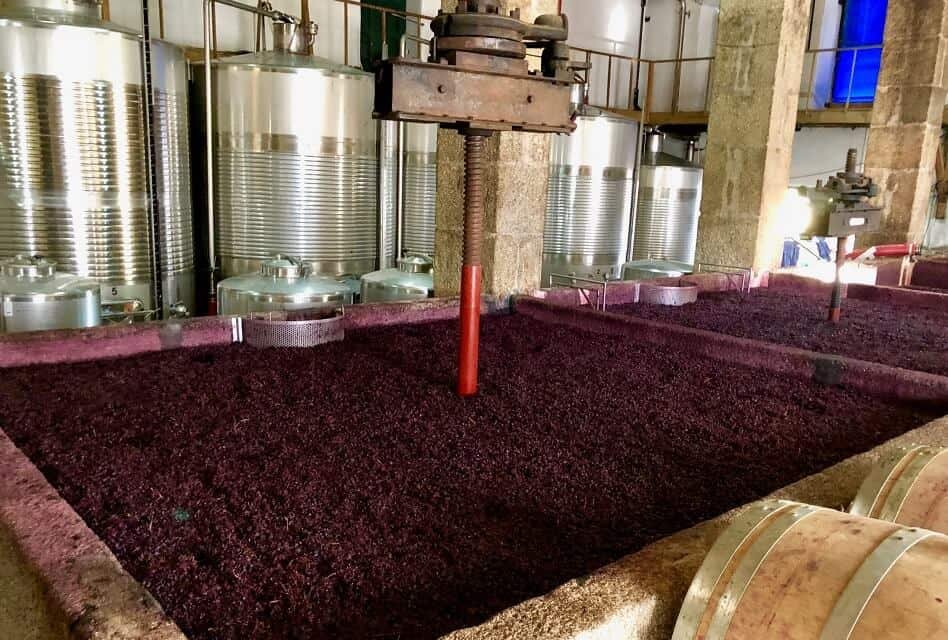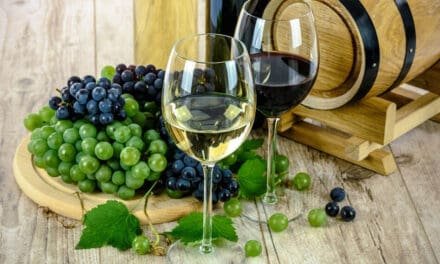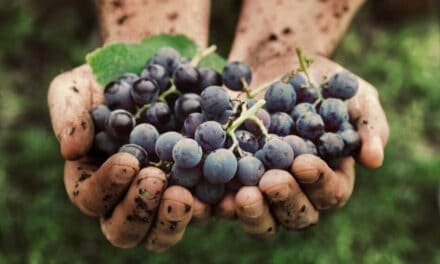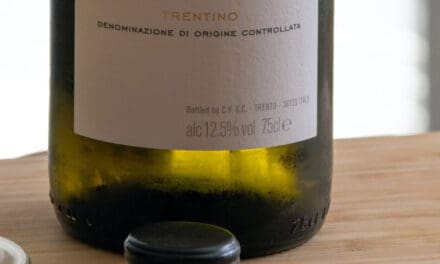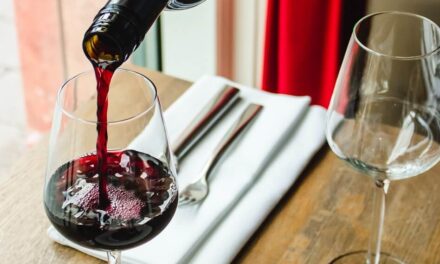Winemaking is a sophisticated and time-consuming process. It consists of multiple stages and can take numerous years until a bottle is ready for sale. At each step of the process, vintners have to make decisions that impact the resulting wine significantly. Depending on their choices, wine can be sweet or dry, light or bold, and it can develop different flavor profiles. But what are these choices? How exactly is Wine made?
Winemaking is a long and complicated process that includes numerous steps: Growing the vines, harvesting and crushing the grapes, fermenting the wine must, aging, fining, and bottling the wine.
During all phases of winemaking, vintners can make numerous decisions that impact the resulting wine. And depending on the desired types of wine, the winemaking steps can differ significantly. In this article, we will discuss all of these steps, and the decisions vintners have to make to produce a high-class wine:
- Step 1: Winegrowing
- Step 2: Harvest
- Step 3: Grape Crushing
- Step 4: Fermentation
- Step 5: Aging
- Step 6: Fining
- Step 7: Bottling
WINEMAKING STEP 1: WINEGROWING
Cultivating vines is the first step in winemaking. And numerous wine experts claim that the vineyard is the place where wine is actually made. And that is right because winemakers’ decisions when growing vines play a crucial role in wine quality.
Grape Varieties
The first decision vintners have to make is which varietal they want to grow. By nature, grapes vary in sweetness, acidity, and level of tannins. So by selecting a variety with the right characteristics, they can lay the foundation for the type of wine they want to produce.
Of course, the grapes must match the climate and the terroir. In many areas, these circumstances limit the number of varietals winemakers can grow. The reason is that they differ in their ability to resist heat, frost, diseases, and pests. For instance, Cabernet Sauvignon grapes are very robust because they have thick skins. In contrast, Pinot Grigio berries have thin skins that make them prone to diseases and sudden temperature changes.
How Terroir Affects Wine
To a large degree, the growth and health of vines depend on terroir, or in other words, on soil quality and topography.
Soil quality determines how easy it is for vines to grow roots and gather nutrients. While different grape varieties have different needs, there are some general requirements for healthy vines. Among them are loose soil texture, good drainage, and proper aeration.
The topography describes the shape of the land. Most vintners prefer hilly areas over flat territory for several reasons. Vines growing on slopes benefit from better drainage and better protection from frost and strong winds. Besides, they can receive more intense sunlight than when planted on flat territory.
To benefit from these effects, winemakers plant their vine stocks on south-facing slopes when working in the Northern hemisphere. That includes all European countries, the United States, and Canada. Vintners in Australia, New Zealand, South America, and South Africa prefer north-facing hills.
Why Climate and Weather Are Important in Winemaking
Climate has a significant impact on wine’s characteristics. When grown in places with high temperatures and much sunshine, grapes ripen sooner and get higher sugar levels. From these grapes, vintners can make sweeter wines or wines that are higher in alcohol (we will talk about that in the section about fermentation). In contrast, cooler climates lead to crisper wines with lighter bodies. When comparing wines from New World wines countries like the United States or Australia to Old World wines from Europe, you can clearly sense these differences.
Besides the general climate, the weather in a single year can affect wine quality massively. Especially in countries with colder climates like France or Germany, rainy summers or early winters can prevent grapes from ripening fully. On the other hand, heat waves might burn them and destroy their natural acidity. And, of course, natural disasters like storms or floods can wipe out a whole year’s harvest.
Vintners have only a few options to combat the negative effects caused by the weather. One way of protecting grapes from being sunburned is to adjust the pruning practices: Vineyard workers leave more leaves on the vines so that they can provide shade for the grapes.
Another option to protect vines from unfavorable weather conditions is adjusting the harvest date. By bringing in grapes earlier or later, winemakers can allow them more or less exposure to sunshine or save them from cold snaps.
How Vines’ Age Affects Wine Characteristics
Many crops, such as tomatoes, carrots, and lettuce, are annual plants. That means they die in winter, and farmers have to sow new plants yearly. Vines are different. They’re perennial plants that can get hundreds of years old. Some of the oldest vines that still produce wine grapes were planted in the 17th century in Slovenia.
According to common belief, old vines produce lower yields and smaller grapes than young vines. And as the smaller grapes develop more concentrated aromas, the resulting wine is said to be better. Wine lovers claim that one of the main reasons is deeper roots that can access more nutrients.
However, empirical evidence does not support this belief, at least in terms of output. According to an Australian study from 2017, older vines actually produce higher yields because they grow bigger. The actual effect of vines’ age on wine quality has not been proven yet. And as quality is an opinion rather than an impartial judgment, it might never be.
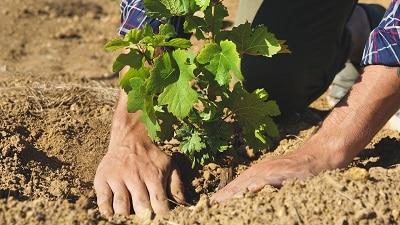
Worker Planting a New Vine
Watering Vines
Proper care of vines includes several aspects. Watering is one of them. The right amount of water is crucial to encourage the growth of vines and grapes. During the budding and flowering of the vines, they typically need more water. But as soon as grapes start ripening, vintners limit the watering. By doing so, they force the vines to assign their limited resources to grow grapes instead of more leaves.The need for artificial watering depends on the climate. In many New World countries like Australia or South Africa, it is absolutely necessary. Because of the hot climate, vintners cannot rely on rainfall there. But in many prestigious wine regions in Europe, winemakers limit the watering to a minimum because they believe that this results in higher-quality wines.Pruning Branches and Leaves
Pruning is another way of keeping vines healthy. It is the practice of trimming leaves and branches. And when making high-quality wine, it is a must-do.When vines have too many branches, they cannot supply all of them with nutrients. As a result, the grapes do not ripen properly and cannot reach their optimal flavor. By removing some branches, the vintners force the vines to put their energy into the remaining canes. So pruning reduces the yield but creates better and more flavorful grapes.Besides, it is necessary to remove rotten and diseased branches to keep the plants healthy. Otherwise, diseases could spread and infect other vines.Typically, winemakers prune their vine stocks after the harvest. Timing is important, though. When they do it too early, vines might suffer from frost. But pruning too late can harm the blooming process in the next spring. So the best time is usually in late winter when temperatures start rising, but the plants do not bloom yet.Additionally, vintners prune their vines in late summer. In this case, they focus on removing leaves. During the summer months, the leaves protect the grapes from being sunburned. But when the hottest time is over, grapes can benefit from a little more sunlight during the last weeks before the harvest. Thus, pruning gives them some extra exposure.Protecting Vines from Pests
Besides protecting the vines from sunburn, vintners also need to shield them from other dangers. Pests, diseases, and fungi can do significant harm to wine grapes and potentially destroy a whole year’s harvest. To prevent hat, winemakers can take various measures:- Insecticides are countermeasures against insects that might harm vines. Among them are leafhoppers that feed on the vines’ leaves, mealybugs that place their eggs in grapes, and cicadas that can transmit dangerous diseases. An insecticide is basically a chemical poison that harms and finally kills these insects. Typically, it comes as a powder or a spray.
- Herbicides aim at weeds and parasitic plants. While these plants usually do not attack vines directly, they compete with them for nutrients, water, and sunlight. And especially newly planted vine stocks that have not developed deep roots yet might be unable to stand this competition. As a result, they might fail to produce healthy grapes. Most modern herbicides are synthetic plant hormones designed to prevent the growth of specific plants.
- Fungicides protect vines from fungi such as powdery mildew. Usually, the wind carries these spores to the vineyard, where they germinate on the vines’ leaves. Over time, they spread and forms a dusty, greyish film that looks like a spider web. This web covers the vine stock and makes photosynthesis (converting sunlight into chemical energy for plant growth) impossible. Fungicides are chemicals that kill existing fungi or destroy spores before they can even spread.
- Bactericides have the purpose of avoiding infections with bacteria. In many cases, these microorganisms are transmitted by insects. If they infect vines, they can block the plants’ water transportation system, delay budding, and harm their ability to consume nutrients. They can even cause the vines to die. Bactericides attack bacteria on a cellular level to kill them.
- Biological measures are alternatives for vintners who follow organic or biodynamic winemaking practices. Chemical agents are typically very effective, but they have side effects. They can pollute the groundwater, harm wildlife, and even negatively affect wine drinkers. Thus, some farmers waive them completely and protect their plants otherwise. For instance, by cultivating specific plants next to their vineyard, they can attract insects that feed parasites. And by properly pruning vines, they can provide sufficient aeration to limit the risk of fungi.
WINEMAKING STEP 2: HARVEST
As soon as the grapes are ripe (or ripe enough), vintners proceed to the harvest. They gather the grapes while leaving the vines intact. Some use modern machines for this purpose. But as machine-harvesting comes with the risk of damaging the grapes or the vines, many winemakers prefer hand-picking. In some cases, they don’t even have a choice because the local wine laws mandate manual harvesting.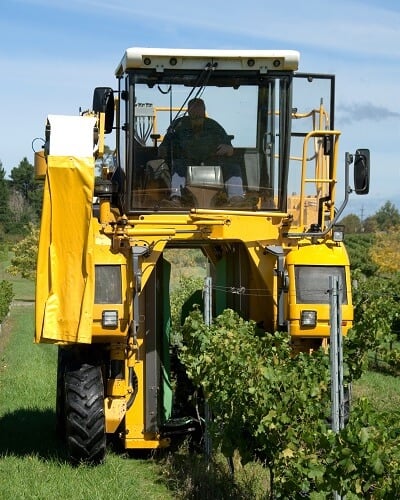
Grape Harvesting Machine
The Right Time for Harvesting
The timing is crucial for planning the harvest. Depending on the desired type of wine, vintners harvest their grapes earlier or later in the year.
The longer grapes stay on the vines, the riper they become. That means they accumulate more sugar and lose their acidity. As a consequence, vintners who want to produce crisp wines harvest relatively early in the year. That’s the case for most white wines and light reds such as Pinot Noir.
If winemakers prefer to produce fuller-bodied red wines, they allow their grapes to stay on the vines longer to produce more sugar. Grapes for dessert wines usually get the most time on the vines. If you read “late harvest” on the bottle label, you’re about to buy one of these sweet wines.
Letting Grapes Rot or Freeze
In some cases, accidents led to the development of very strange winemaking practices.
For example, in the late medieval, delayed harvest resulted in grapes infected with noble rot. The fungus dried out the grapes and let them shrivel. But instead of dumping them, winemakers proceeded the fruits into incredibly sweet wines.
Ice wine resulted from a similar accident: Due to early onsets of winter, grapes froze on the viners. When pressed, they released only a tiny bit of juice, but this juice was very rich in sugar. And it made fantastic dessert wines. Today, vintners let their grapes freeze intentionally to make ice wines.
Letting Grapes Rot or Freeze on the Vines
In some cases, accidents led to the development of very strange winemaking practices.
For example, in the late medieval, delayed harvest resulted in grapes infected with noble rot. The fungus dried out the grapes and let them shrivel. But instead of dumping them, winemakers proceeded the fruits into incredibly sweet wines.
Ice wine resulted from a similar accident: Due to early onsets of winter, grapes froze on the viners. When pressed, they released only a tiny bit of juice, but this juice was very rich in sugar. And it made fantastic dessert wines. Today, vintners let their grapes freeze intentionally to make ice wines.
Grape Selection
After bringing in the harvest, vintners proceed by selecting the proper grapes for their wines. They sort out those that are damaged, rotten, not fully ripe, or otherwise unusable. Additionally, they also remove other plant material such as leaves or branches.
Typically, the grape selection is a manual process. In particular, vintners who produce high-quality wines prefer to sort their grapes by hand. And in some European regions, vintners even have to sort them manually if they want to use certain quality labels for their wines.
Based on the desired quality, they either select whole bunches of grapes or only single berries. Especially when making high-quality dessert wines, they are extremely picky.
Many modern wineries use automatic devices instead of manual selection. For this purpose, there are different types of machines:
- Some models determine the size of a grape and simply sort out those that are too small.
- Others sort them based on their density. They run the grapes through a container with liquid. While the healthy, ripe grapes sink to the container’s ground, the unripe berries float, and the machine sorts them out.
- The latest technology takes electronic pictures of each grape. Based on these pictures, an algorithm evaluates which grapes appear unhealthy and removes them.
WINEMAKING STEP 3: GRAPE CRUSHING
The next step in the winemaking process is the crushing of the grapes. It is a very straightforward process: The workers put pressure on the grapes to burst their skins, so they release their juice. At this time, the juice is called “must”.
Like for grape selection, there are different methods of crushing grapes. Stomping them with bare feet was the historical way. In many European countries, winemakers still follow this practice. It is also part of traditional wine festivities like the Madeira Wine Festival.
Of course, vintners also can use machines instead. They range from old-fashioned mechanical crushers to engine-driven high-tech machines.
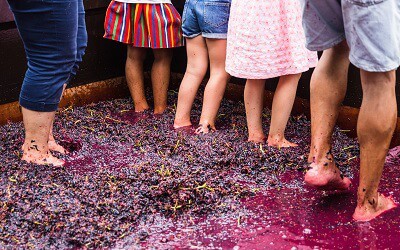
Grape Crushing During Madeira Wine Festival
Removing Grape Solids
Depending on the wine they want to make, winemakers might have to remove grape solids from the must. The reason is that the solids are responsible for giving the wine its color. Interestingly, this is true for both red and white grapes.To get the desired color, vintners have to take different actions regarding grape solids:- When making red wines, they allow the solids inside the fermentation container to impart red color on the wine.
- White wines should be pale yellowish, so winemakers remove the solids from the must.
- Rosé wines are special: They stay with the solids, but only for a limited amount of time. As a result, they get a pinkish color that is much lighter than typical red wines.
- Another unique type is orange wine. It is made from white grapes, but unlike white wine, it stays in contact with the grape solids for some time. Thus, the wine turns orange or amber-colored.
WINEMAKING STEP 4: FERMENTATION
Fermentation probably is the most crucial part of winemaking. At this point, the grape juice transforms into wine.To start this process, vintners transfer the crushed grapes into a fermentation container. Then, they add yeast to the must. Yeasts are microscopic single-celled fungi. They play important roles not only in winemaking but also in making beer or bread. When added to the must, they start feeding on the grape sugar and transform it into alcohol. As a by-product, they also produce carbon dioxide (which is essential for making sparkling wine).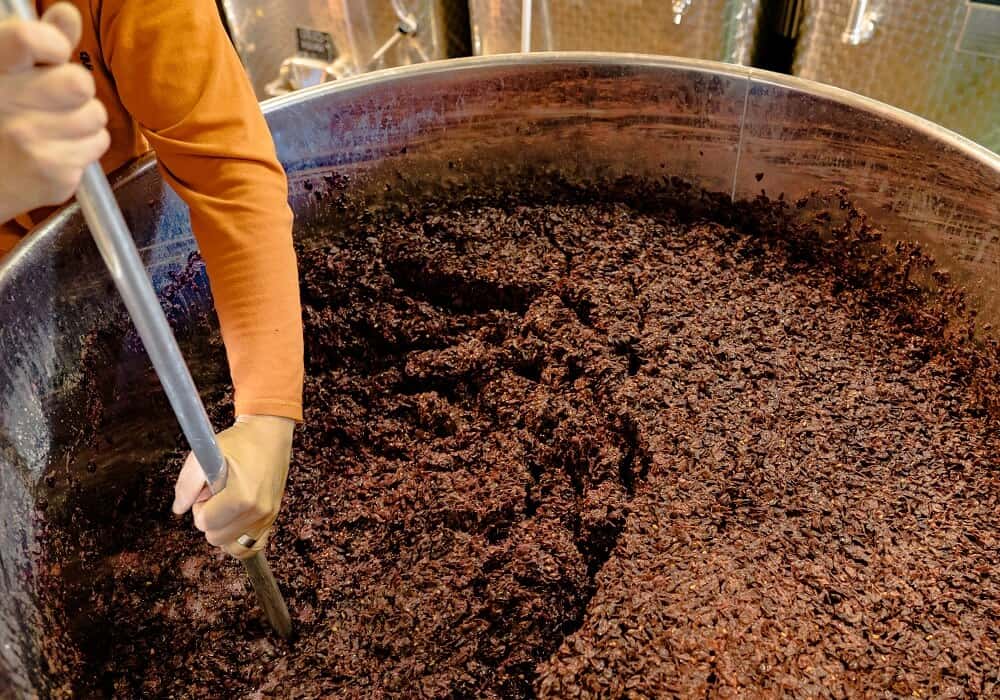
Worker Stirring Fermenting Grapes
Besides, many other chemical processes happen during the fermentation:
- Ester molecules that are bound to the grape sugars are set free. They contribute fruity and floral aromas to the wine.
- The yeast produces low amounts of sulfites that help protect the wine from going bad.
- Anthocyanins impart color to the wine. As these components occur in the grape solids, they only can do their job if the vintner doesn’t remove them.
- The alcohol that is produced in the process enhances the extraction of tannins. Tannins are naturally present in the grape solids, and when these solids float, they make their way into the wine must. They add bitterness and produce an astringent, puckering mouthfeel.
Temperature Control
The right temperature is crucial for the fermentation process, too. By altering it, vintners can impact the wine’s characteristics significantly.
Higher temperatures increase the speed of tannin extraction, leading to a more tannic wine. As this is a desired characteristic for many red wines, they usually ferment at temperatures between 70 and 80°F (21-27°C).
For white wines, vintners choose temperatures of about 45 to 60°F (7-15°C). Fermentation at these temperatures promotes the development of fruity aromas.
No matter which temperature winemakers choose, they must monitor the containers closely at any time. The reason is that fermentation is an exothermic process. That means it produces heat. To avoid the temperature rising too high, they have to take measures to adjust it regularly. Otherwise, it could kill the yeast. Winemakers must also prevent the temperature from dropping too low because that could slow down the fermentation process.
Fermentation Duration
The fermentation process has two stages: The first is called “primary fermentation” or “aerobic fermentation”. Typically, it takes around one week. During that stage, the yeast cells multiply themselves rapidly. To enable them to do that, vintners need to allow oxygen inside the vessel.
“Secondary fermentation” is the next stage, also referred to as “anaerobic fermentation”. Depending on the amount of sugar that’s available, it can take one to two weeks. Vintners reduce the amount of air in the container, so the yeast cells stop reproducing and instead focus on converting sugar into alcohol. While they continue to do so, the fermentation will slow down observably.
The fermentation process naturally stops as soon as the yeast cells have consumed all of the sugar. In this case, the result will be a dry wine. In case vintners want to make a sweet wine, they have to stop the process artificially. They can do so by lowering the temperature, so the yeast cells stop consuming sugar or by raising it to kill them. Alternatively, winemakers can add strong alcohol, such as Brandy, to the wine. This spirit stops the fermentation process, too. But as it increases the alcohol volume massively, it is only an option for fortified wines.
Fermentation Vessels
The type of vessels that vintners use has an impact on secondary fermentation. Those vessels that let some air in to allow further oxidation alter the wine’s characteristics significantly. Here are the most common types of fermentation containers:
- Containers made from oak wood let some oxygen in, which softens tannins and acidity, so the wine becomes more balanced.
- In contrast, stainless steel tanks are airproof. They prevent oxidation and preserve the original characteristics of crisp and fresh wines.
- Vessels from concrete allow minimal oxidation and pass mineral aromas to the wine.
- Clay containers let a bit of air inside. They can add subtle earthy notes to the wine, but generally, they are rather neutral.
WINEMAKING STEP 5: AGING
After successful fermentation, some vintners proceed with aging their wine. The purpose of aging is to allow the wine to develop more delicate flavors and a better balance. You can think of it as seasoning. These improvements are the results of chemical processes that happen over time. Oxygen plays a vital role in these processes. So just like in fermentation, winemakers expose their wine to some air intentionally.
An aging process is not a necessary step in winemaking, and some wines do not qualify for it whatsoever. But on the other hand, laws in some European wine regions mandate vintners to age their wines if they want to carry a specific quality label.
Typically, red wines, especially those with high tannin levels and a full body, undergo an aging process. For white wines, it is rather uncommon. Nevertheless, there are some bolder whites that vintners do age, for example, Chardonnay or Sauvignon Blanc from New World wine countries.
Oak Aging
The most common way to age wine is oaking. The vintners transfer their wines into oak barrels and let them sit there for some time. It is not unusual that the process takes multiple years.
As oak wood is not completely airproof, oxygen can get into the barrels and start the chemical processes that improve the wine. The numerous results of these processes change a wine’s characteristics significantly. These are the most important effects:
- Like many other plant matter, oakwood contains tannins. And when it gets in contact with the wine, it slowly imparts these tannins onto it. So oaked wine tends to be more tannic than unoaked wine.
- At the same time, aggressive tannins get a bit softer. The exposure to oxygen softens the wine and gives it a silky texture. The result is a much smoother wine.
- Oakwood contains components called phenols. These components contribute to developing new aromas when they get in touch with wine. They can create notes of vanilla, dried fruits, tobacco, coffee, or spices.
- Oak aging leads to a concentration of flavors. The reason is evaporation: As the wine is in contact with air, it slowly reduces. Its flavors concentrate on the remaining wine that gets much more intense in the process.
- Finally, oaking gives the wine a more intense color.
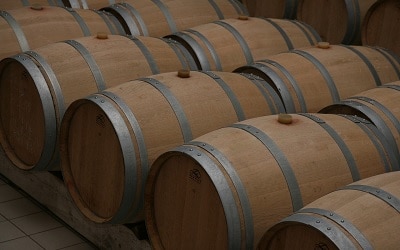
Oak Barrels
Tank Aging
A widespread alternative to oak aging is the use of stainless tanks. They are a favorable choice because they allow bulk aging and are easy to clean. Besides, unlike oak barrels, they do not have to be replaced after a couple of years. So by using steel tanks, the cost of winemaking can be reduced.The effect of steel tanks on wine is very different from the effect of oak barrels. As they are airproof, they make it much easier for the vintner to control the oxygen flow. They do not impart new flavors to the wine and do not soften them significantly. Thus, they are the right choice for vintners who want to produce light and crisp wines. Especially white wine and sparkling wine producers rely on tank aging.Bottle Aging
Another way to age wine is bottle aging. As the name suggests, vintners mature their wine in glass bottles.Bottle aging has a couple of advantages over oak aging, but also some disadvantages. On the one hand, it is typically faster and allows more control for the vintner. But on the other hand, glass cannot pass new flavors to the wine. Also, it does not allow oxygen into the bottle. So, in the end, bottle aging does not change a wine as significantly as oak aging.For sparkling wine producers, bottle aging is a standard method. The world’s best sparklers, such as Champagne or Franciacorta, undergo this way of aging. It is also not uncommon that vintners use both oaking and bottle aging one after another to optimize their wines’ flavors.WINEMAKING STEP 6: FINING
One of the last steps in winemaking is the fining stage. Its primary purpose is to optimize a wine’s taste, but it also has other effects. Here is what fining can do:- Soften a wine’s tannins and reduce the bitterness they create.
- Filter out solid particles (sediments), including dead yeast cells, that give the wine a cloudy look.
- Adjust the wine’s color.
- Gelatine, a protein from the skins and bones of cattle and pork. It can soften tannins, reduce bitter flavors, and clarify wine.
- Casein, a protein from cow milk. It clarifies wine and stabilizes it by preventing over-oxidation.
- Egg whites from hens’ eggs. They can soften tannins.
- Isinglass is collagen obtained from fish’s swim bladders. It clarifies wine and intensifies wine color.
- Bentonite, a special type of clay. It filters out other protein-based fining agents after they’ve done their job.
- Silica gel, a porous form of silicon dioxide. It helps filter out dead yeast cells.
- Charcoal. It has the ability to reduce off-flavors and reduce color intensity.
WINEMAKING STEP 7: BOTTLING
The final step of winemaking is transferring the wine into bottles. Nowadays, this happens through automated bottling lines. But before the wine is ready for sale, the vintner has to make some more decisions that can affect wine quality. Most importantly, they must decide which type of packing and sealing to use. Also, they might want to take measures to preserve the wine.Bottle Material
Most wine containers are made from glass, and for a good reason. Glass is leakproof, airtight, and neutral in smell, making it an excellent container for wine. The fact that glass is fragile and can shatter easily is unfortunate but acceptable.
The bottle color is an important factor in wine preservation. Green or brown glass works like sunglasses: It shields the wine from light that can potentially harm it. And especially for a wine that is supposed to be stored for multiple years, winemakers rely on these glass types. Some of them, like Port wine producers, even use black glass to protect their wines.
Light wines tend to come in colorless bottles. As they are made for early consumption, exposure to light is not a big problem. So vintners prefer to showcase their wines and waive the protective ability of colored glass.
Plastic packages are common for cheaper wines. They come in boxes that typically have a bigger volume than glass bottles. Although many wine lovers frown upon these packages, they are not necessarily indicators of inferior wines.
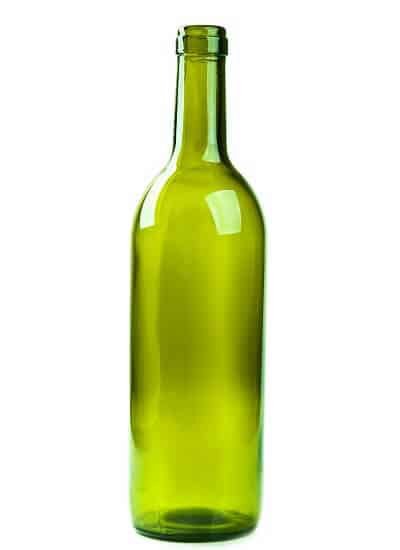
Typical Wine Bottle Made from Green Glass

